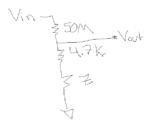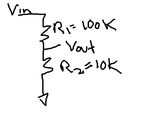mrblueblue1234
Junior Member level 1

In the attached image I am showing a voltage divider with the values of 50M (fixed) , 4.7k (fixed) and an unknown impedance Z.
Is it possible to calculate the value Z only using Vin, 50M and the 4.7k without using Vout directly?
I am looking for a simplified equation for Z that doesn't explicitly need Vout.
For this same application I saw a formula that didn't include Vout here so I was curious on the details.
Thank you for your thoughts.

Is it possible to calculate the value Z only using Vin, 50M and the 4.7k without using Vout directly?
I am looking for a simplified equation for Z that doesn't explicitly need Vout.
For this same application I saw a formula that didn't include Vout here so I was curious on the details.
Thank you for your thoughts.




